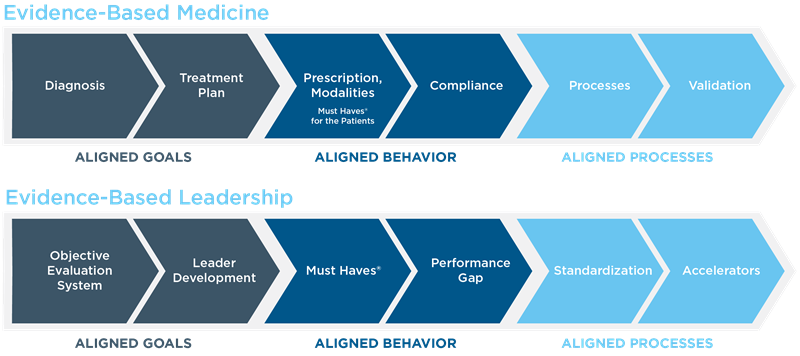In Brief
Contact Us To Speak At Your Organization
The Structure and Focus That Create a High-Performing Organization
Every healthcare organization aims to provide high-quality care and exceptional patient experiences in every care interaction. However, an ever-changing industry landscape consistently challenges an organization’s ability to do so. Effective leadership is critical to addressing these challenges before leaders can drive their organizations forward.
Implementation, not motivation, is where most leadership falls short. A culture grounded in accountability with well-trained clinicians focused on quality does not happen on its own. Leaders need a framework that aligns goals, behaviors and processes.
Evidence-Based Leadership: The Foundation of a Culture of Quality
What is Evidence-Based Leadership?
Evidence-Based LeadershipSM is an approach to leadership modeled after the concept of evidence-based medicine and is designed to hardwire the behaviors that have been shown through evidence to have the greatest impact on patient outcomes. The Evidence-Based Leadership framework serves two purposes: It provides the structure for hardwiring behaviors, and it solidifies a culture of accountability.
To achieve and sustain the quality outcomes it takes to thrive in the healthcare environment, every clinician needs to consistently perform the right behavior in the right way. The Evidence-Based Leadership (EBL) framework drives consistency in any behavior — in experience of care as well as in processes of care, flow and safety. As the EBL tools and tactics are taught, reinforced and measured, organizations will see growth in employee engagement and passion as well as improvement in patient outcomes.
How Does Evidence-Based Leadership Work?
As organizations seek to improve quality, they may implement a new process on top of an old process. They may not address endemic leadership issues that are holding departments back. They may neglect to explain the “why” behind the changes they are asking people to make.
The Evidence-Based Leadership framework provides the “why” behind changes — the reason leadership is choosing this process to manage this aspect of care delivery to achieve this outcome. It ensures the “why” is clearly communicated and that leadership and clinicians are aligned on the right metrics to fulfill the organization’s mission. It confirms that everyone knows how success is measured and the behaviors that lead to that success. Lastly, it ensures everyone is held accountable for doing their part.
Evidence-Based Leadership can be applied to:
- Patient and staff rounding
- Verifying vitals and medication dosage
- Implementing heightened safety precautions
- Addressing new patient inquiries
- Increasing patient experience and satisfaction
- Improving patient meal experience
- Implementing new care measures for specific conditions
- Aligning nursing, pharmacy and lab staff
- Optimizing flow in the emergency department
Why Does Evidence-Based Leadership Work?
When a new behavior is hardwired — meaning it has become second nature and not performing the behavior is no longer tolerated — people will keep doing it automatically, even after the organization moves on to its next focus. An evidence-based approach solidifies cultural and organizational changes by instilling the meaning behind the change. Clinicians develop a greater sense of trust in leadership, making clinicians want to commit to practicing and perfecting new behaviors.
As care delivery grows more complex, it is critical for leadership and clinicians to be aligned on goals and tactics that fulfill the organization’s mission. Evidence-Based Leadership provides the structure for creating and cementing this alignment and increasing clinician accountability, all to the benefit of patients.
KEY TAKEAWAYS
-
Think differently.
Recognize that communicating cultural and organizational change is not enough; it is also important to communicate the “why” behind the change. -
Plan differently.
Invest the time and resources it takes to hardwire new behaviors and establish a culture built on accountability. -
Act differently.
Work to align leadership and clinicians on the goals, behaviors and processes that best connect to the organization’s mission of delivering exceptional patient care.

